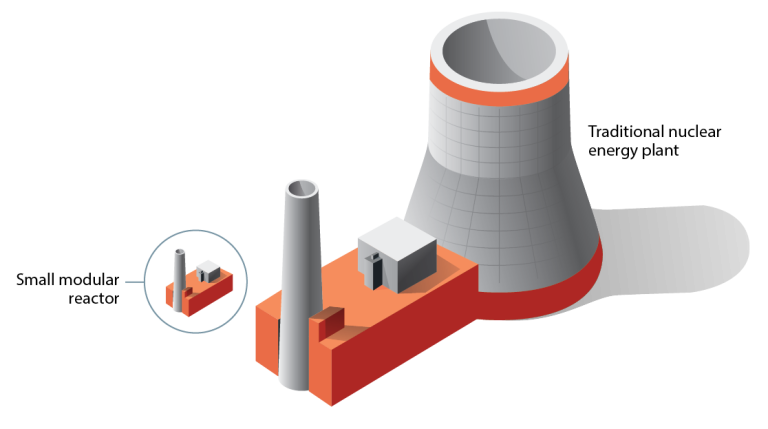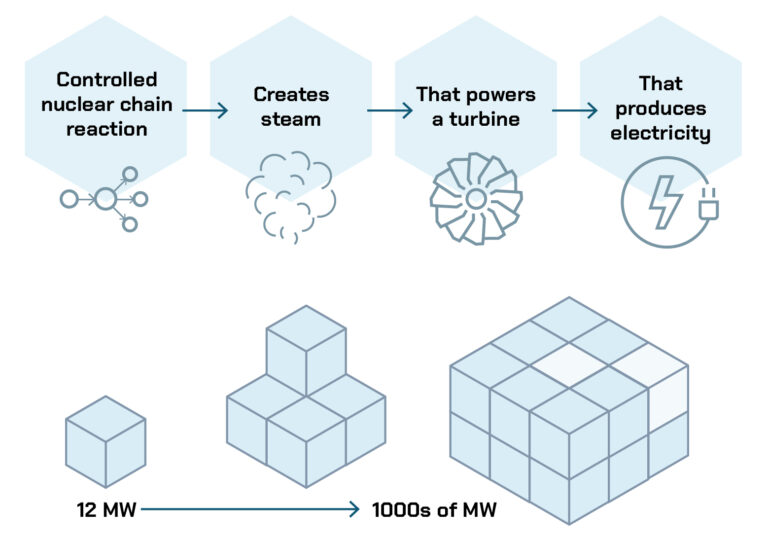Advanced Small Modular Reactors
What are Small Modular Reactors?
A small modular reactor (SMR) is a nuclear fission reactor that features factory-built-and-assembled modules in a variety of configurations and electricity outputs. About 1/10 to 1/4 the size of a traditional nuclear energy plant, SMRs feature compact, simplified designs with advanced safety features. Small modular reactors are envisioned to vary in size according to configuration.
Modular designs make it possible to assemble major reactor components in a factory and add reactor modules as needed. SMRs can be used for power generation, process heat, desalination or other industrial applications.

Why are Small Modular Reactors Important?
Nuclear energy generates more than half of the nation’s carbon-free electricity. Advanced small modular reactors offer advantages such as relatively small size, reduced capital investment, ability to be sited in locations not possible for larger nuclear plants, and provisions for incremental power additions. SMRs also offer distinct safeguards, security and nonproliferation advantages. Specific benefits include:
Configurability
Small modular reactors can be customized for a location depending on generation needs and the available infrastructure, such as transmission line capacity. Units could be added as demand increases.
Modularity
Small modular reactor modules can be assembled in a factory, then transported to the operating location, substantially reducing costs and construction time.
Flexibility
Small modular reactors generate clean, carbon-free electricity as well as heat, a necessary ingredient for industrial chemical processes to make plastics and other materials for consumer goods.
Reliability
Just like other sources of baseload energy, SMRs can produce electricity 24/7 and be ramped up or down based on demand.
Energy Concentration
Small modular reactors pack a lot of energy punch in a relatively small footprint. For example, a proposed 920-MW NuScale SMR would have a 35-acre footprint, while a traditional nuclear plant generating the same amount of electricity would require nearly 500 acres.
Adaptability
SMRs complement other clean energy sources such as wind and solar. Pairing small modular reactors with renewables can ensure emission-free energy is always available.
Enhanced Safety
Small modular reactor designs include passive safety features that rely on the natural laws of physics to shut down and cool the reactor during abnormal conditions.
How do Small Modular Reactors Work?

Like any fission reactor, a small modular reactor uses energy from a controlled nuclear chain reaction to create steam that powers a turbine to produce electricity. Advanced SMR designs span a range of sizes and technology options. Some use light water as a coolant while others rely on coolants such as a gas, liquid metal or molten salt. Some SMRs would use fuel akin to what runs today’s nuclear reactors, while others would use new types of fuels.
Different designs can have different end uses such as power generation, process heat supply or desalination. Small modular reactors also can vary in size from a dozen megawatts to hundreds of megawatts per module. Modules can be added or taken offline to match electricity demand, giving the plants immense flexibility. The modules can also be individually refueled so that an SMR plant is never fully offline.
